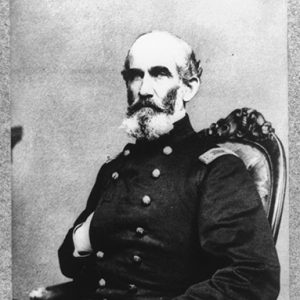calsfoundation@cals.org
Andrew Jackson Smith (1815–1897)
Andrew Jackson Smith was a Union major general during the Civil War, commanding a division during the capture of Fort Hindman at Arkansas Post and during numerous other campaigns.
Born in Bucks County, Pennsylvania, on April 28, 1815, Andrew Jackson Smith was the son of Samuel Smith and Anne Lacey Wilkinson Smith. Entering the United States Military Academy at West Point in 1834, Smith graduated four years later and received a commission as a second lieutenant and served with the First Dragoons. Smith slowly rose through the ranks over the next two decades, serving on the western frontier and in the Mexican War, including with the Mormon Battalion.
Smith married Ann Mason Simpson on October 17, 1844, in St. Louis, Missouri. The couple had at least one son, William.
On May 13, 1861, he was promoted to the rank of major in the regular army and became the colonel of the Second California Cavalry that October. After serving with that unit for less than a month, Smith was named chief of cavalry of the Department of Missouri in February 1862, before assuming the same position in the Department of the Mississippi in March. Leading his units in the capture of Corinth, Mississippi, Smith was commissioned as a brigadier general on March 17, 1862. Service continued in both Kentucky and Tennessee before Smith joined Major General William Tecumseh Sherman at the Battle of Chickasaw Bayou in late December 1862.
After the defeat at Chickasaw Bayou, Smith and his division were placed under the command of Major General John McClernand and joined his expedition against Fort Hindman, located near Arkansas Post. Using a combined army-navy force, McClernand arranged his two corps against the fort and line of trenches that stretched to the west. Smith’s division was placed with its left flank resting near the fort, while the majority of the men faced Texas troops manning the trench. Eventually, the Federal forces prevailed, and the Confederates under the command of Brigadier General Thomas James Churchill surrendered. Smith’s division suffered the most casualties of the four divisions that participated in the action.
Returning to the eastern bank of the Mississippi River after the capture of Fort Hindman, Smith led a division during the siege of Vicksburg, including battles at Port Gibson and Champion’s Hill. After the fall of Vicksburg on July 4, 1863, Smith continued to command divisions in Tennessee and Kentucky. Returning to the Trans-Mississippi Theater in the spring of 1864, Smith commanded a large detachment from the Union Army of the Tennessee during the Red River Campaign. Operating in conjunction with Major General Frederick Steele’s Camden Expedition moving into southern Arkansas, Major General Nathaniel P. Banks planned to move up the Red River and work with Steele to capture Shreveport, Louisiana, headquarters for the Confederate Department of the Trans-Mississippi. After meeting and being defeated by a Confederate army near Mansfield, Banks fell back to Pleasant Hill, where troops under Smith prepared a defensive position. On April 9, 1864, Confederate forces struck the Union army again, and Smith faced off against Arkansans under the command of Brigadier General Thomas James Churchill. The Federals were able to hold the field but continued their retreat down the Red River.
Smith once again moved to Tennessee and Mississippi, where he served during the summer of 1864, leading troops at the Battle of Tupelo. Spending time in Missouri, where he worked to protect St. Louis from Confederate forces under the command of Major General Sterling Price, Smith concluded the war leading the XVI Corps. Promoted to major general of volunteers on May 12, 1864, Smith concluded the war as a brevet major general in the regular army.
After the war, he served as the colonel of the Seventh Cavalry, as well as of the Department of Missouri, before resigning in 1869. He subsequently served as the postmaster and city auditor for St. Louis and died on January 30, 1897.
For additional information:
Christ, Mark K. Civil War Arkansas, 1863: The Battle for a State. Norman: University of Oklahoma Press, 2010.
Eicher, David, and John Eicher. Civil War High Commands. Redwood City, CA: Stanford University Press, 2001.
Warner, Ezra. Generals in Blue. Baton Rouge: Louisiana State University Press, 1964.
David Sesser
Henderson State University

 Andrew J. Smith
Andrew J. Smith 



Comments
No comments on this entry yet.